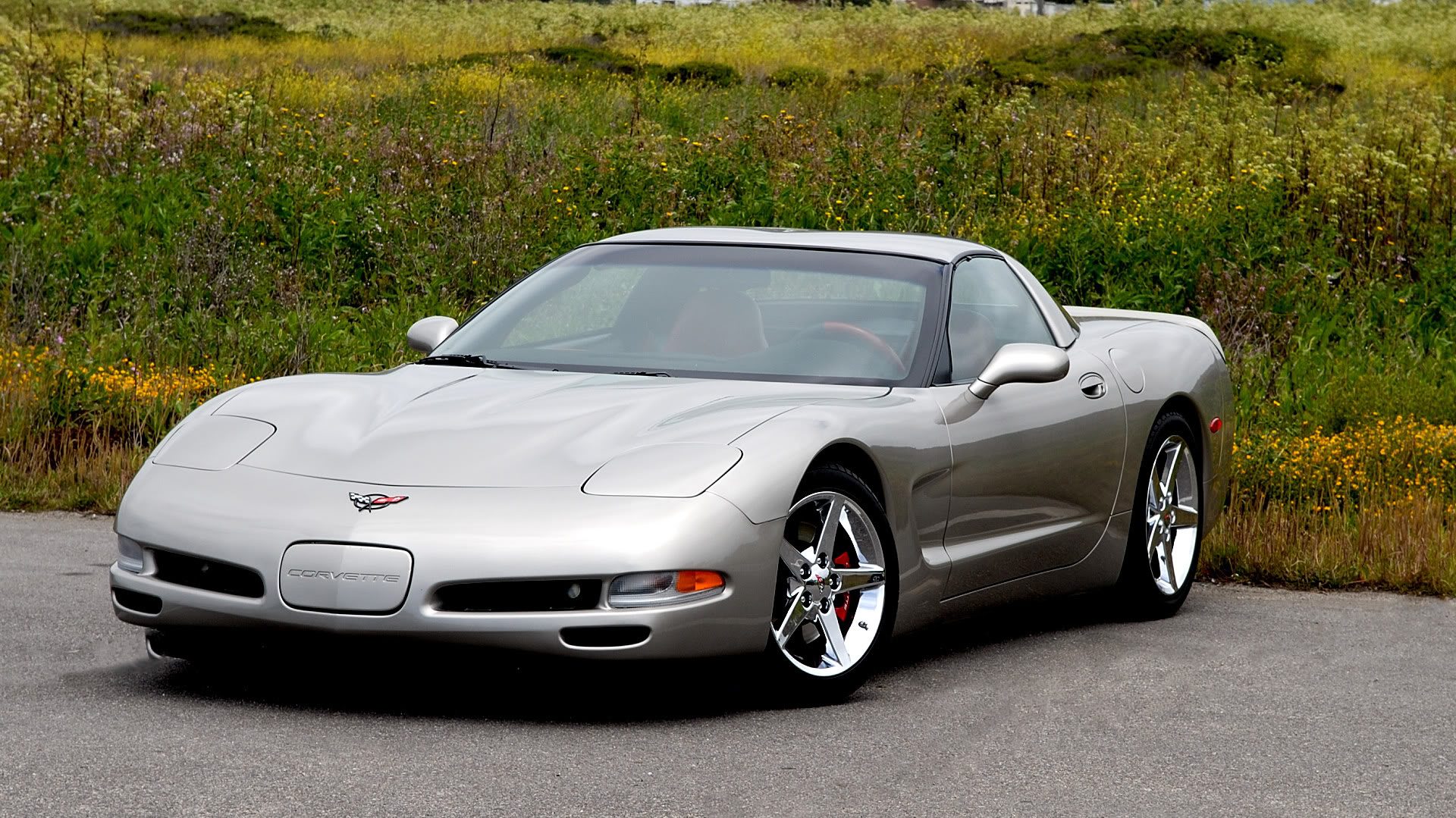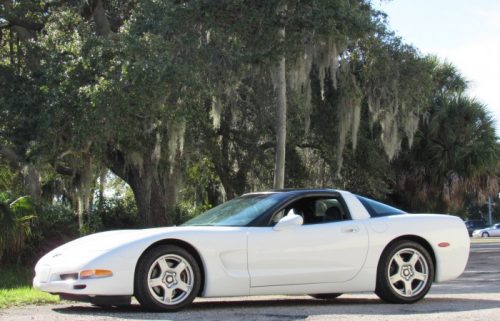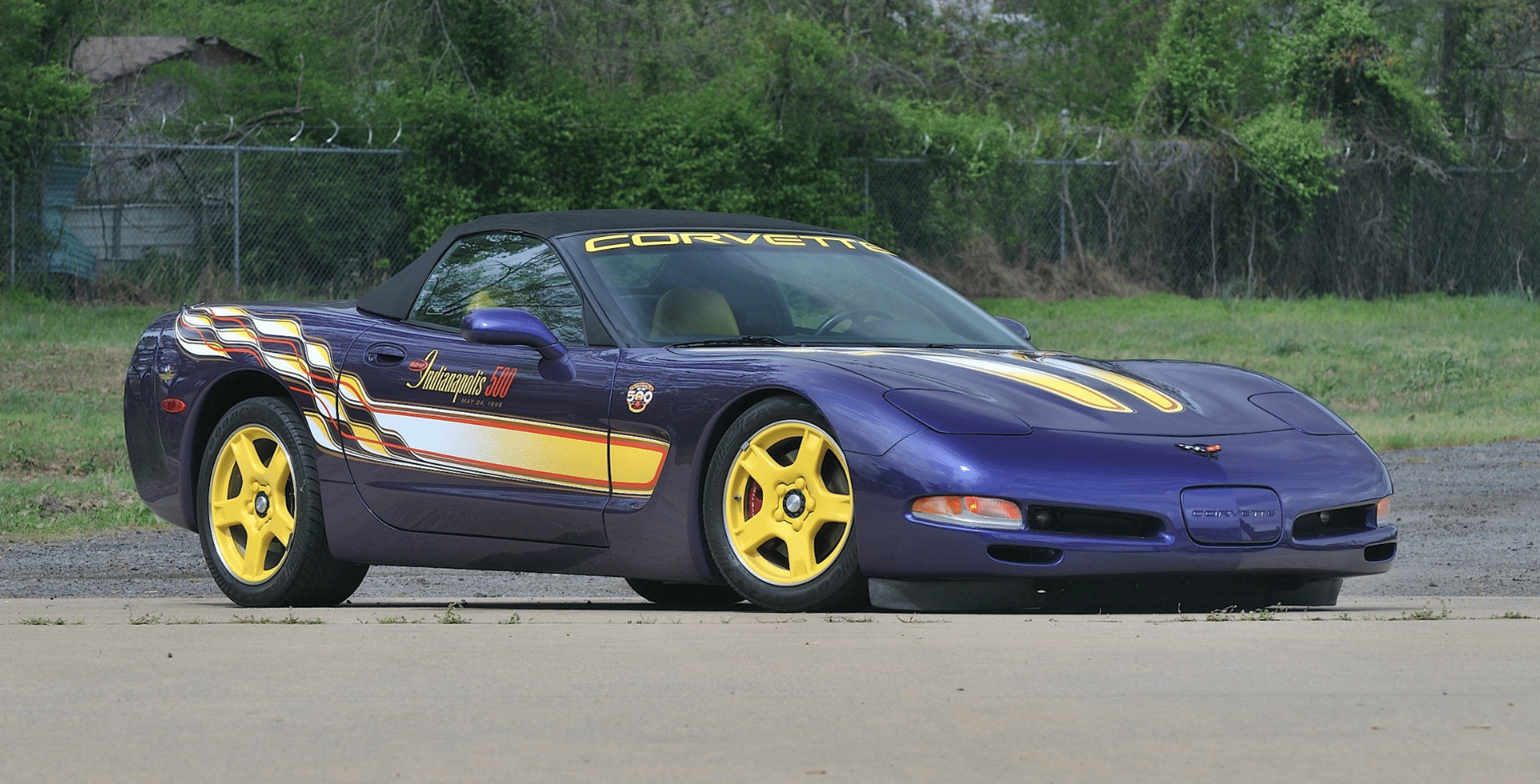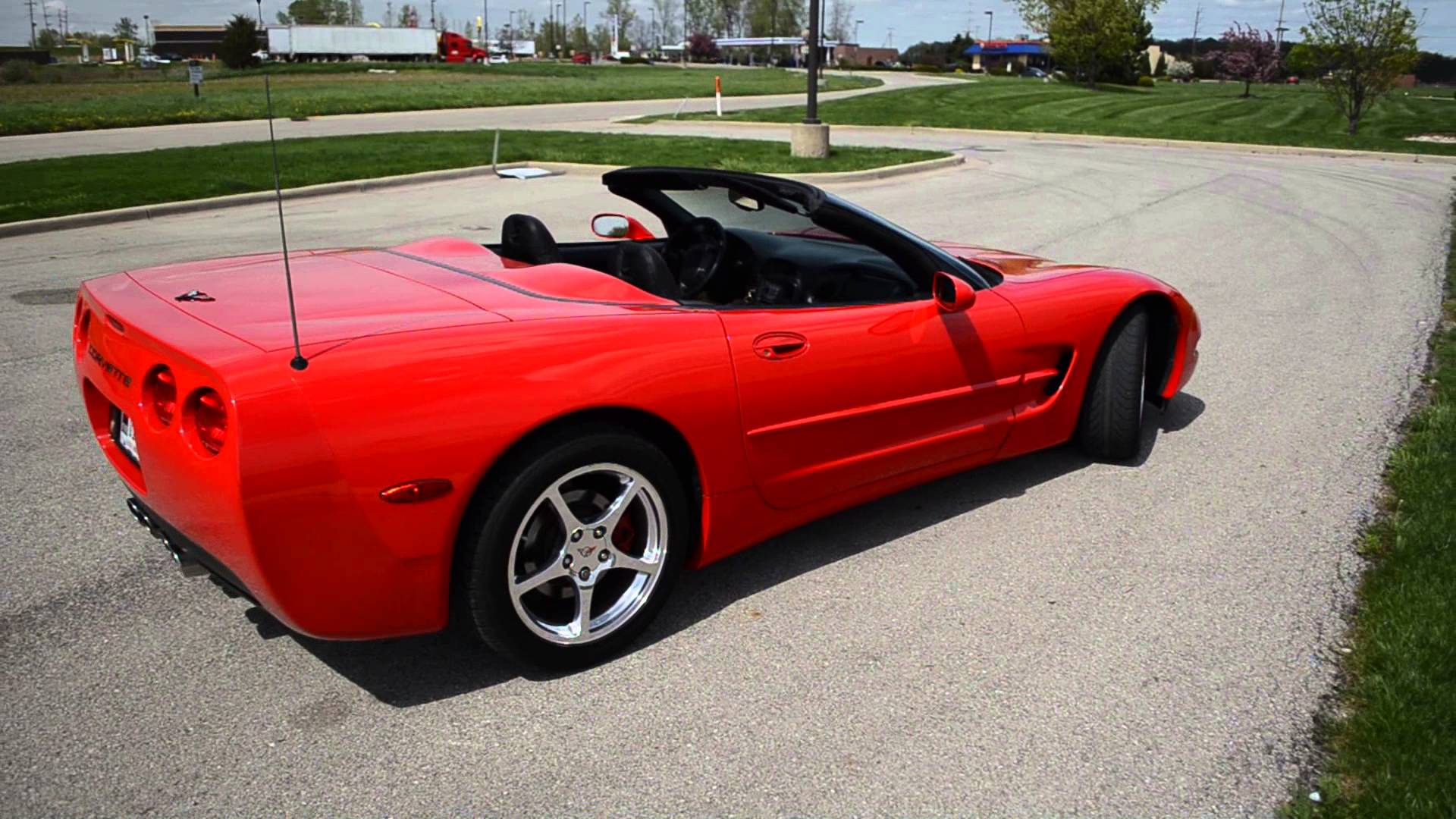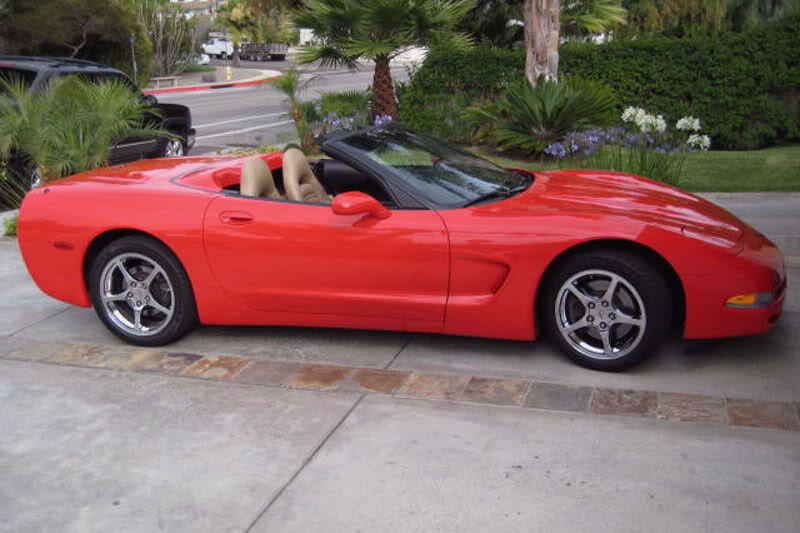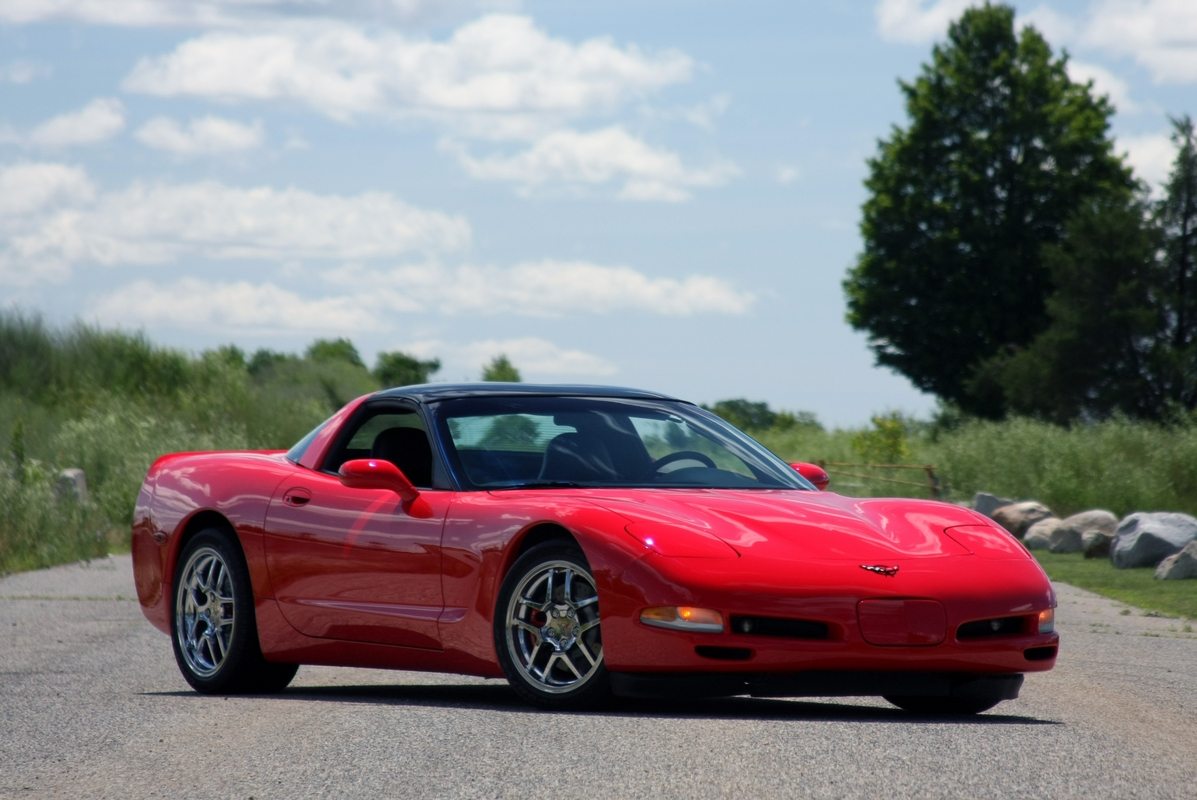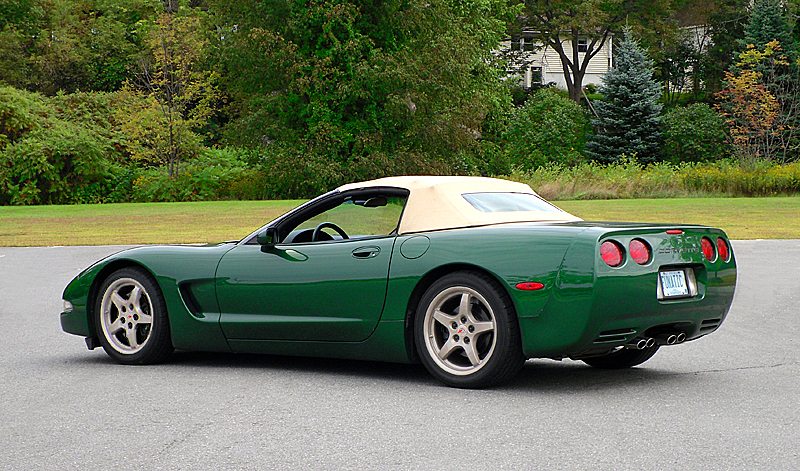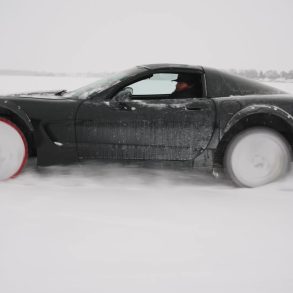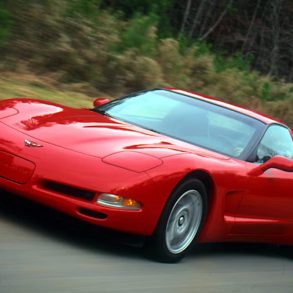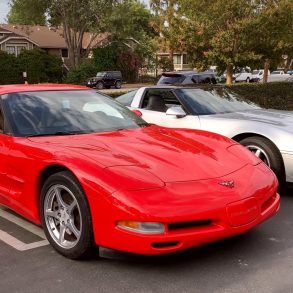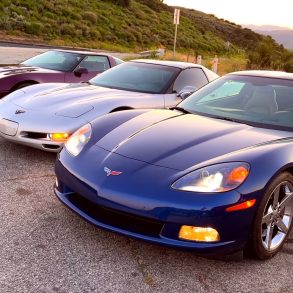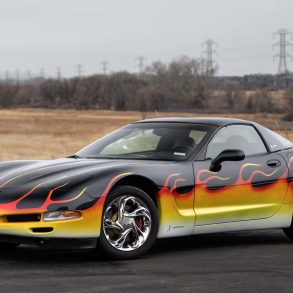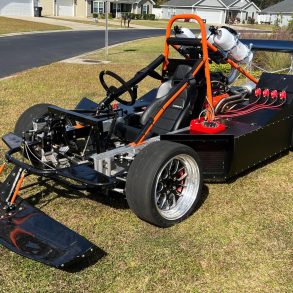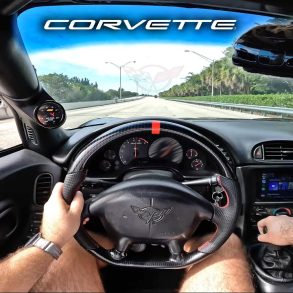1998 Corvette – The Ultimate Guide
Despite the limited number of units produced in 1997, there was no question that the new C5 Corvette was anything less than a phenomenal success. Enthusiasts and critics alike praised the car for its outward appearance, improved ergonomics, impressive drivability and handling, uncompromising performance capabilities, and its complete feeling of precision and quality. General Motors had hit a home run from the very start, leaving many questioning with eager anticipation how the C5 could possibly be improved upon.
The answer was simple enough. For its sophomore year, Chevrolet introduced an all-new convertible companion to the C5 coupe. The plan had been to build the convertible from the very start of the C5 project and, as a result, the execution of putting the design to production was far simpler than the development of a convertible variant might have been had such measures not been taken.
In truth, the C5 Corvette had been engineered to accommodate a convertible top without the necessary heavy structural reinforcements most convertible cars require. The benefit of this intentional design strategy was that the C5 Convertible would not require extensive reworking, it would weigh just one pound more than the coupe, and it would retain almost all of the structural rigidity of its coupe counterpart. Additionally, the C5 convertible actually weighed 114 pounds less than the C4, yet it was four times more torsionally sound than its predecessor.
The Corvette design team, working carefully to maximize functionality of the available space on the car while focusing on developing a rag-top design that was more streamlined than earlier models, created a Corvette convertible that was both practical and very aesthetically pleasing.

For starters, the C5 convertible included a functional trunk – which was the first time a trunk had been included on a convertible Corvette since 1962 – and at 13.9 cubic feet, it was not just a small cubbyhole but rather a cargo area that provided genuine and practical functionality.
Amazingly, given the space limitations commonly associated with a Corvette, the C5 convertible’s trunk space was larger than that of any other contemporary convertible from that time. Another of the design elements that paid homage to the C1 was the revival of the convertible’s “waterfall”, a body panel that continued down from the tonneau, flowing between the seats just as it had on the 1953 thru 1962 Corvette. This new “waterfall” was so carefully incorporated into the design of the C5 convertible’s interior that its seams were nearly indiscernible from the rest of the tonneau (all of which is used to carefully conceal the convertible top when it is lowered.)
Finished with the Corvette emblem and painted to match the rest of the exterior, it provided another design element to the already sophisticated interior and helped add to the genuine “roadster” look that made Corvette so appealing all the way back in its earliest days.
The convertible top itself was also a fusion of effective design and simplicity. The top itself featured a glass rear window that included an electric defroster as part of the standard convertible package.
While the double-lined top still had to be raised and lowered manually (as with all generation Corvette convertibles before it), this new top was lighter and easier to operate than the C4’s. It could be raised or lowered in about 20 seconds.
However, because of the tops weight and release points, it was not possible to lower the top while seated inside the vehicle. While considered a minor inconvenience by some, the new design did offer several upsides as well.
For one, the convertible top now used the tension of its raised framework to hold the bottom in place. This new design eliminated the need for the many unsightly tonneau anchor holes and roof locator pins that were always synonymous with earlier Corvette convertible tops.
Making a return for a second year was the LS1 small block V-8 engine. Now available as the standard (and only) power plant for both the coupe and the convertible, this new engine delivered 345bhp (brake-horsepower) at 5,600rpm and 350 lb-ft of torque at 4,400rpm.
While the engine displacement was the same as the C4’s LT1, this 5.7 liter engine was constructed of aluminum instead of iron and was a more aggressive, more durable design than its predecessor. Also a carry over from its predecessor, the LS1 shared the same time-honored “440” cylinder block layout (meaning 4.40 inches from bore center to bore center) and the familiar 5.7-liter displacement label.
Specified to run on premium fuel and filled with synthetic oil from the factory, the new LS1 had to be carefully fitted into the body of the Corvette. In fact, the engine clearances were so minimal, the new oil pan that was mated to the LS1 engine was scarcely 5 inches deep, yet offered increased capacity and the ability to supply lubricant during even the most extreme cornering maneuvers.
Even more impressive was the fact that this new 5.7 liter engine weighed 45 pounds less than the LT4 engine that it replaced, while still producing enough power to make it a serious contender against the former ZR1’s power plant.
Mated to the new LS1 engine was a standard, four-speed automatic transmission gearbox. As with the C4 before it, a Borg-Warner six-speed manual transmission was offered for an additional $815.00 (although this transmission was a revised version of its previous generation’s counterpart.) As with before, the new six-speed included the optional first-to-fourth Computer-Aided Gear Selection (CAGS) skip shifter. While the linkages were more complex than before, the six speed transmission’s shift effort and feel were very reminiscent of the C4.

In an effort to increase the equal distribution of weight, the C5’s transmission was relocated to the rear of the car. Located just in front of the rear axle, the transmission was mated to the LS1 engine via an aluminum tube which ran through an enclosed tunnel that formed a chassis backbone strong enough to reduce structural loads on the outboard frame rails.
Relocating the transmission to the rear axle produced the desired balancing result with a 51/49 percent weight distribution. This equal distribution of weight would result in an automobile that was better-balanced and better equipped to handle the rigors of even the most aggressive drivers.
Further, this new layout was the direct result of a car that hadn’t solely been the brain-child of a single designer, but rather the response by GM to understand the considerable number of customer (and enthusiast) inputs that had driven the development of this car – including a call for friendly handling, roominess in the cockpit, and a solid, silent automobile. Another added benefit of relocating the transmission to the rear of the Corvette was the elimination of the former toe-pinching tunnels of the C4.
As has always been the case with General Motors, safety was a major concern in the development of both the C5 coupe and convertible. Many key safety features that were introduced in the 1997 Corvette carried over for the 1998 model year, while several others were introduced with the onset of the convertible. Daytime automatic running lights were included in both variants of the car to provide increased visibility of the Corvette during daytime operation.
Four-wheel antilock brakes, which were also standard in the previous platform, were also provided as a standard feature. Manufactured by Bosch, the ABS system helped to reduce wheel lockup and maintain driver steering control while braking – even on slippery surfaces. Safety cage construction and a high-strength perimeter frame were part of the design and, as mentioned earlier, attributed to the elimination of additional engineering that is generally required when rolling out a convertible variant. Other features to return for 1998 included driver and passenger side air bags as well as PASS-Key II theft deterrent system.
The Corvette had always been considered a platform for innovation of new technologies, and the C5 was no exception. Both the 1998 coupe and convertible featured a number of technical innovations that helped make owning a Corvette that much easier for. These included a 10,000 mile recommended oil change interval. Admittedly, this option, while a good selling point, also required that a number of specific driving conditions be met. Still, with the specified Mobil 1 synthetic oil being nearly $5.00 a bottle in 1998, this was definitely a marketing point worth noting. An engine air-filter monitor was also installed that would indicate when the filter would need to be replaced. Like the extended oil life, the primary purpose of this monitoring system was for the benefit of consumers who were feeling the pinch at their wallets.
DID YOU KNOW: In 1998, General Motors experimented with a couple of paint colors that were never “officially” issued as optional choices to consumers. In preparation for its 50th Anniversary, Chevrolet produced fifteen Corvettes with a high metallic painted they called “Aztec Gold.”
The paint was initially applied to 5 Corvettes on October 22, 1997. When painting was finished, GM engineers and designers noted that the individual body panels did not appear to match one another in certain light conditions.
With the guidance of some experts at DuPont, a second batch of 5 Corvettes were painted with the special “Aztec Gold” color on November 17, 1997, with the same results. A third set of 5 were painted on November 26, 1997, but in all cases, the only consistency with this color was that the body panels of every Corvette seemed to vary from one another.
In an effort to reduce the color differences, the panels were removed from all 15 of the Corvettes (which consisted of 3 convertibles and 12 coupes), and each component was matched to others whose color was most similar. It is said today that no two “Aztec Gold” Corvettes look the same.
While many Corvette enthusiasts might argue that the Aztec Gold was the rarest color of the 1998 Corvette vintage, they would be wrong.
Late in the production year, GM introduced a new paint color, “Navy Blue Metallic” but, due to its late introduction, a very limited number of orders was placed – 14 Corvettes in all – for this color, making Navy Blue Metallic the rarest paint color for the ’98 model year.
Like the 1997 before it, the 1998 Corvette was fitted with Goodyear Eagle F1 GS Extended Mobility Tires. These tires were designed to run airless for 200 miles. Their introduction to the extended mobility tires convinced Chevrolet to eliminate the spare tire and jack altogether, which further aided engineers in reducing vehicle wait while also increasing cargo space. The inflation level of the tires was monitored constantly and could be called up on an instrument-panel display (thanks to the on-board tire monitoring system that has since become standard on almost every GM vehicle.)
Wheel diameter was again increased to 17 inches in the front of the car but was increased an inch to 18 in the rear. The tires, which were sized 245/45ZR-17 and 245/45ZR-18 respectively, were actually slightly narrower than the 1996 model’s base tire package. This proved to be an advantage as the somewhat narrower tires actually aided in improving the directional stability to levels unsurpassed by General Motors. Optional magnesium wheels were introduced in the 1998 model year, but the $3000.00 optional rims proved to be unexpectedly popular, and were later discontinued for the model year when supplies ran out.
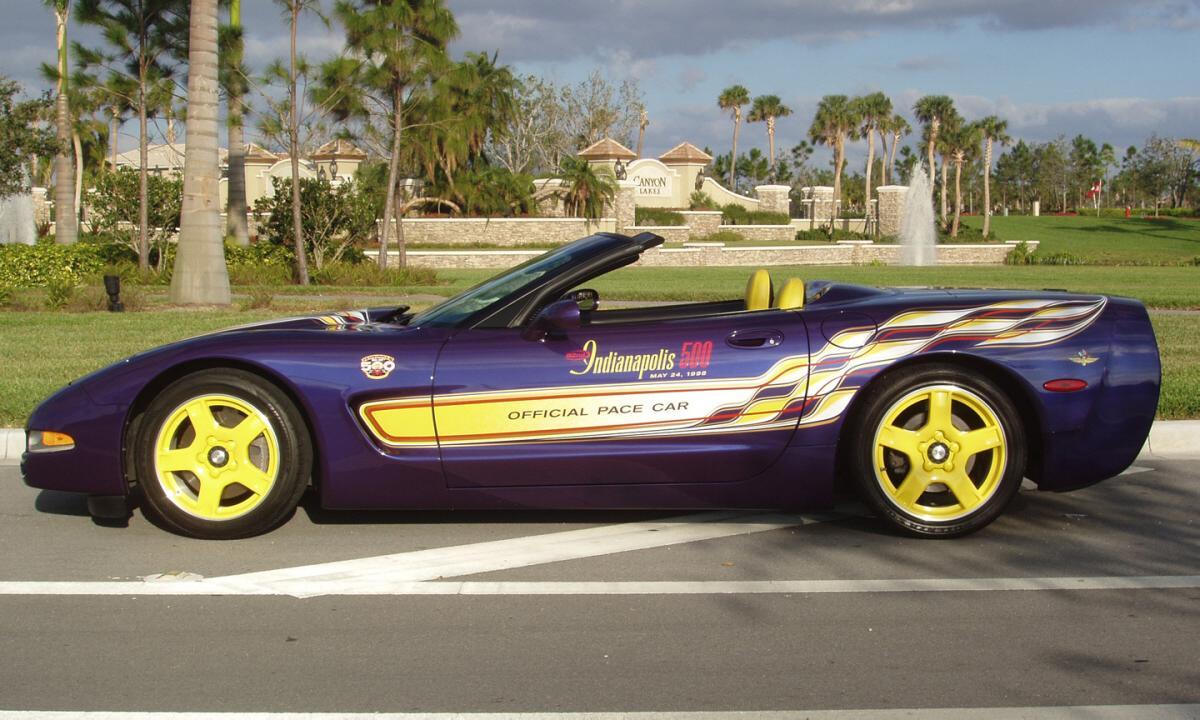
Considering the incredible reception that the 1997 Corvette received, it was really no surprise that the 1998 C5 convertible was very well received by enthusiasts and critics alike – so much so in fact that it was selected as the official pace car of the 1998 Indianapolis 500.
This would be the fourth Corvette to serve as a pace car for this race, and while Chevrolet planned on marking the occasion by creating a special edition pace car model, the mechanical modification from the stock convertible were actually very few. The pace car’s LS1 engine received a freer-flowing intake manifold and a modified exhaust system boosted the car’s horsepower by 25, taking it to a total of 370hp.
The car’s overall ride-height was lowered slightly, a roll bar was mounted behind each seat, and rear-facing strobe lights were integrated into the tonneau’s fairings.
To commemorate the occasion, Chevrolet manufactured 1,158 pace-car replica convertibles for distribution to dealerships across the country. Listed as option RPO Z4Z, this option package-price carried an additional cost of $5,039.00 (and an additional $5,804.00 for customers who wanted their cars equipped with a manual transmission.) Interestingly, the replicas did not include any of the mechanical tweaks or safety features that were featured on the actual pace car. They did, however, include the exclusive radar-blue paint, decals, two-tone upholstery, and yellow wheels. They also included most of the otherwise optional equipment available for the model year and featured a new Corvette performance option – an anti-skid system known as the new Active Handling System (RPO JL4).
The new Active Handling System was available to consumers for an additional $500.00 and was designed to send an impending skid during a turn. In such an instance, the car’s ABS/computer systems would take over and, by selectively applying individual brakes and activating the standard traction control system, would bring the car out of a skid and back under control – at which point it would immediately relinquish control back to the driver.
Much like the standard ABS system, this special Active Handling System functioned in real-time and was designed to aid drivers only as long as it was needed. The system did not affect throttle control, and keeping in character with the Corvette’s sporting nature, this system also featured a “competition mode”. By pressing a button on the console, the “competition mode” could be activated, thereby disengaging the Active Handling System and allowing drivers to drive the cars where some rear-wheel spin was actually desirable, as in extreme cornering situations on race tracks and in drifting conditions.
DID YOU KNOW: While today’s Corvette convertibles are usually about 15% to 20% more expensive than the base coupe, this wasn’t always the case. In the 1960’s and ‘70s, the “ragtop” Corvettes were actually less expensive than the base coupes, with the base coupe generally costing approximately $300 to $400 more than the convertible.
There were a number of minor improvements made to the 1998 Corvette platform which included a modified accessory drive tensioner, the removal of an alternator brace that produced a high-rev “whining” sound, improved window seals and, later in the production run, a quieter electric fuel pump. While none of these improvements affected drivability, each was made to help reduce unwanted drive noise.
Additional mechanical improvements were made which included increasing the power-steering system’s caster angle to provide better tracking and an optional Real-Time Damping suspension to aid in better wheel control. The transmission oil cooler was manufactured out of stainless steel instead of a copper-nickel alloy, and, perhaps the most significant from a driver’s perspective: the standard four-speed automatic transmission was modified to include an optional second-gear start mode to reduce (and often eliminate) wheel spin from a standing start on slick roads.
Production Volumes
Sales numbers for the 1998 C5 Corvette were incredibly positive – and affirmed that the positive press and overwhelming positive response was more than just talk. For its first full model year, a total of 31,084 units were sold – which equated to the highest production total of Corvettes in 12 years. Priced at $37,495.00 for the coupe and $44,424 for the convertible (which was a comparable price spread to the C4 coupe and convertible), the new convertible accounted for approximately 38% of the total units sold that year. Needless to say, General Motors was thrilled by the sales results and again, people were asking how the team responsible for the C5 Corvette were going to top their current efforts.
Little did anyone realize that the answer was just a little more than a year in the making, and would leave a mark on the Corvette legacy that would carry across two generations of the incredible sports car, forever transforming the franchise from being a respected American sports car to instead being recognized and accepted globally as one of the top automotive contenders in the world.
1998 Corvette Awards & Accolades
- Motor Trend – “Car of the Year for 1998”
- NAIAS – “Car of the Year for 1998”
- Car and Driver – “10 Best Cars for 1998”
- Popular Science – “Best of What’s New Grand Award”
- Automobile – “1998 Technology of the Year, LS1 5.7 V8 Engine”
- Ward’s Auto World – “Best Engines of 1998”
1998 Corvette Specifications & Performance
See the complete breakdown of technical specifications for the 1998 Corvette, including engine, suspension, brakes, body dimensions, and power. Read more: 1998 Corvette Specifications.
Engine, Transmission & Performance
Making a return for a second year was the LS1 small block V-8 engine. Now available as the standard (and only) power plant for both the coupe and the convertible, this new engine delivered 345bhp (brake-horsepower) at 5,600rpm and 350 lb-ft of torque at 4,400rpm. While the engine displacement was the same as the C4’s LT1, this 5.7 liter engine was constructed of aluminum instead of iron and was a more aggressive, more durable design than its predecessor. Also a carry over from its predecessor, the LS1 shared the same time-honored “440” cylinder block layout (meaning 4.40 inches from bore center to bore center) and the familiar 5.7-liter displacement label. Mated to the new LS1 engine was a standard, four-speed automatic transmission gearbox (manual an option).
1998 Corvette Vehicle Identification Numbers (VIN)
The last six digits begin at 100001 and run through 131069. A total of 31,084 Corvettes were built in 1998. Each Vehicle Identification Number (VIN) is unique to an individual car. For all 1998 Corvettes, the Vehicle Identification Number was stamped on a plate on the inner vertical surface of the left windshield pillar visible through the windshield. Read more: 1998 Corvette VINs.
1998 Corvette Price & Options
Core Features & Factory Options
The C5 convertible made it’s debut in 1998 and was chosen as the pace car for the Indy 500. Only 1,163 pace car replicas were built sporting purple paint with bright yellow graphics and wheels. New optional magnesium wheels were introduced which were painted a bronze color, these lightened the car, and your wallet costing $3,000. Run-Flat tires were standard on all cars and avoided having to carry a spare tire.
The rear window in the new convertible is made of glass with a heater element for defrosting. It also has an express down feature that automatically opens the tonneau cover and lowers the windows a small amount with the press of a button. Something the world had not witnessed in 36 years – a conventional trunk on a new Corvette. It was last seen in 1962, the final year of the C1 but was now part of every convertible. The C3 and C4 convertibles had minimal storage accessed through the passenger compartment.
New optional “Active Handling System” (AHS) applies brakes individually when the car detects that it is sliding. This new system uses yaw and pitch sensors to determine how the car is moving and can correct for understeer and oversteer to keep the car from going out of control. Corvettes equipped with AHS also have the “Competitive Mode”, this mode turns off the traction control but leaves the AHS active for Gymkhana and Autocross competition. Dual airbags are standard safety equipment on C5.
Colors
The exterior colors and production falls out like this for the 1998 model year: Arctic White 3,346 (10.76%), Light Pewter Metallic 3,276 (10.54%), Sebring Silver Metallic 4,637 (14.92%), Pace Car Purple 1,163 (3.74%), Navy Blue Metallic 14 (0.05%), Nassau Blue Metallic 1,098 (3.53%), Black 6,597 (21.22%), Light Carmine Red Metallic 1,567 (5.04%), Aztec Gold 15 (0.05%), Torch Red 8,767 (28.20%), Fairway Green Metallic 223 (0.72%), Medium Purple Pearl Metal 381 (1.23%), Read more: 1998 Corvette colors
Pricing & Options
The Base Corvette Coupe with 346 cu. in. 345 hp engine and four speed automatic transmission started at $37,495, while the Base Corvette Convertible with 346 cu. in. 345 hp engine and four speed automatic transmission was notably more expensive at $44,425 starting price.
| CODE | DESCRIPTION | QUANTITY | RETAIL PRICE |
| 1YY07 | Base Corvette Sport Coupe | 19,235 | $37,495.00 |
| 1YY67 | Base Corvette Convertible | 11,849 | $44,425.00 |
| AAB | Memory Package | 24,234 | $150.00 |
| AG2 | Power Passenger Seat | 28,575 | $305.00 |
| AQ9 | Sport Seats | 22,675 | $625.00 |
| B34 | Floor Mats | 30,592 | $25.00 |
| B84 | Body Side Moldings | 17,070 | $75.00 |
| CC3 | Removable Roof Panel, Blue Tint | 5,640 | $950.00 |
| C2L | Dual Removable Roof Panels | 6,957 | $650.00 |
| CJ2 | Electronic Dual Zone Air Conditioning | 26,572 | $365.00 |
| D42 | Luggage Shade and Parcel Net | 16,549 | $50.00 |
| F45 | Selective Real Time Damping, electronic | 8,374 | $1,695.00 |
| G92 | Performance Axle Ratio (automatic) | 13,331 | $100.00 |
| JL4 | Active Handling System | 5,356 | $500.00 |
| MN6 | 6-Speed Manual Transmission | 7,106 | $815.00 |
| NG1 | Massachusetts/New York Emissions | 2,701 | $170.00 |
| N73 | Magnesium Wheels | 1,425 | $3,000.00 |
| T96 | Fog Lamps | 29,310 | $69.00 |
| UN0 | Delco Stereo System with CD | 18,213 | $100.00 |
| U1S | Remote Compact 12-Disc Changer | 16,513 | $600.00 |
| V49 | Front License Plate Frame | 16,087 | $15.00 |
| YF5 | California Emissions | 3,111 | $170.00 |
| Z4Z | Indy Pace Car Replica ($5,804 w/Manual Trans.) | 1,163 | $5,039.00 |
| Z51 | Performance Handling Package | 4,249 | $350.00 |
Read more: 1998 Corvette pricing and factory options.
1998 Corvette Gallery
The stylists went back to the Corvette roots with the “waterfall” interior in the new convertible for the 1998 model year. A more open effect was the result of extending the exterior into the interior, a common styling element of classic sports cars. See full 1998 C4 Corvette Image Gallery
1998 Corvette Videos
See more 1998 Corvette Videos


